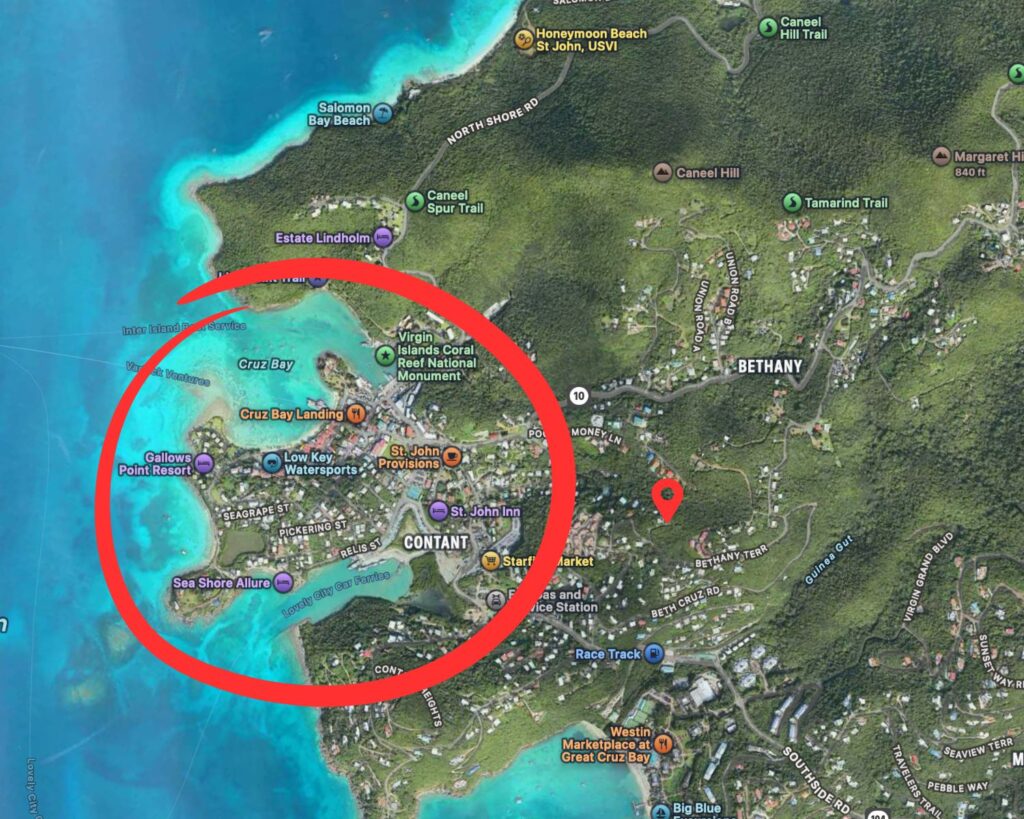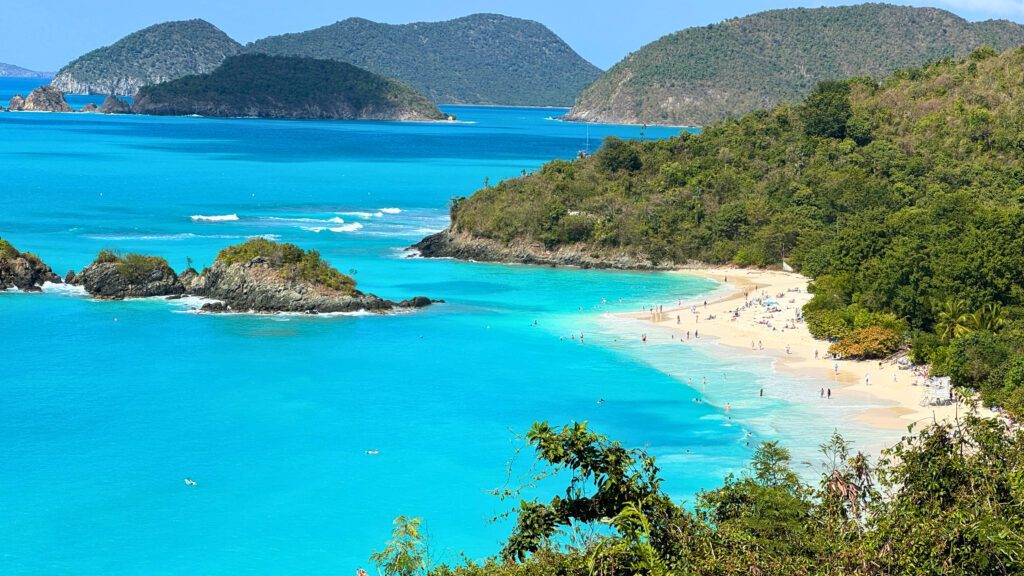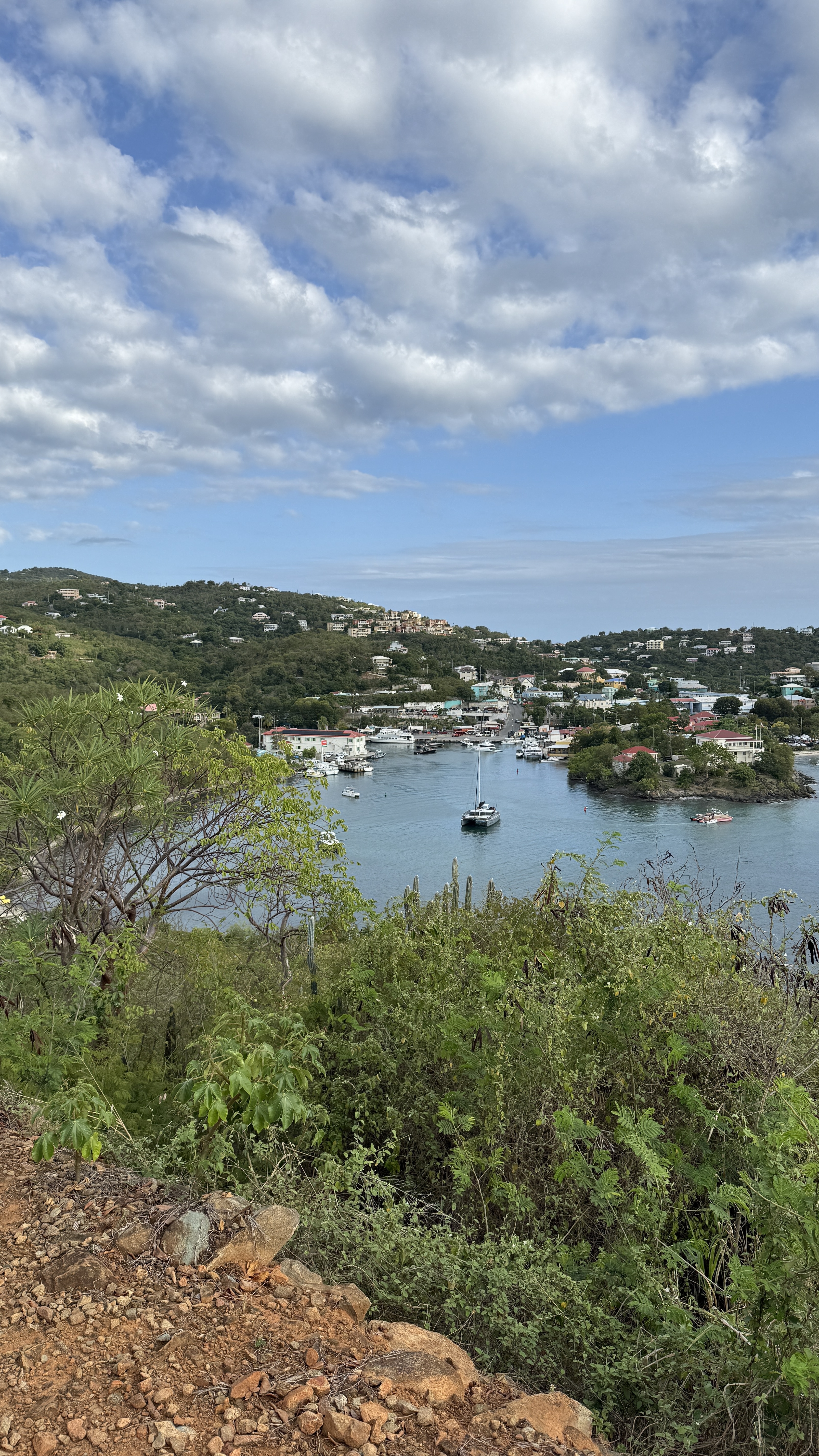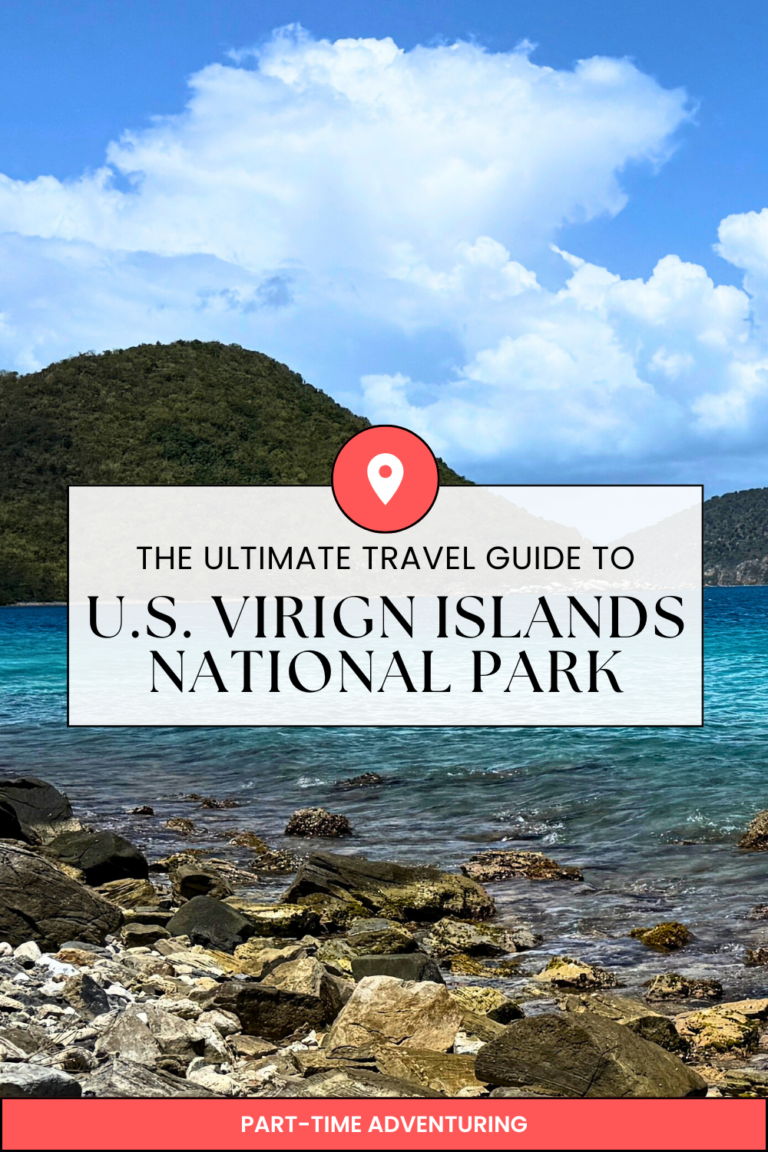Virgin Islands National Park on St. John is one of the most beautiful and underrated national parks in the U.S. With pristine beaches, lush hiking trails, and incredible snorkeling, it’s the perfect mix of adventure and relaxation. Here’s everything you need to know about visiting Virgin Islands National Park.
Understanding the U.S. Virgin Islands & Virgin Islands National Park
The U.S. Virgin Islands (USVI) is a Caribbean territory of the United States, known for its stunning beaches, turquoise waters, and rich cultural history. The territory consists of three main islands:

- St. Thomas – Home to the capital, Charlotte Amalie, and the busiest airport, this island is known for its bustling cruise port, duty-free shopping, and scenic overlooks.
- St. John – The least developed of the three, St. John is where Virgin Islands National Park is located, covering about 60% of the island’s land area and surrounding waters. It offers pristine beaches, hiking trails, and historical ruins.
- St. Croix – The largest of the USVI, known for its Danish colonial history, world-class scuba diving at Buck Island Reef National Monument, and vibrant cultural festivals.
There are also several smaller islands, such as Water Island and Hassel Island, that are part of the U.S. Virgin Islands.
Where is Virgin Islands National Park?
Virgin Islands National Park is located on St. John, the smallest of the three main U.S. Virgin Islands. The park covers roughly 60% of the island, protecting lush tropical forests, coral reefs, and historic ruins. Established in 1956, the park was donated to the U.S. by Laurance Rockefeller to preserve its natural beauty.
What makes Virgin Islands National Park unique is its mix of terrestrial and marine environments—it’s not just a land-based park but also includes 5,500 acres of submerged land, protecting coral reefs, sea turtles, and marine life. The park features:
- Over 20 hiking trails, ranging from easy coastal walks to strenuous treks leading to petroglyphs and plantation ruins.
- Some of the most beautiful beaches in the world, including Trunk Bay, Maho Bay, and Cinnamon Bay.
- Snorkeling and diving spots filled with vibrant coral reefs, tropical fish, and sea turtles.
- Historic ruins, such as Annaberg Plantation, which offers insight into the island’s colonial history and the legacy of sugar plantations.
With its breathtaking scenery, diverse wildlife, and outdoor adventures, Virgin Islands National Park is a must-visit for anyone traveling to the Caribbean. Whether you’re looking to relax on the beach, explore underwater ecosystems, or hike through tropical forests, this park has it all.
Getting to St. John
Flights & Ferries
The closest airport is Cyril E. King Airport (STT) on St. Thomas. From there, you’ll need to take a taxi to the ferry terminal. There are plenty of taxi transit vans at the airport, and you pay per person and an added fee for luggage. Two main ferries run to St. John:
- Red Hook Ferry: Runs every hour, takes about 15 minutes. We took this ferry.
- Crown Bay Ferry: Runs less frequently but is much closer to the airport. This ferry ride is around 35 minutes long.
Once on St. John, renting a car is highly recommended for easy access to Virgin Islands National Park. You can rent a car on St. Thomas and take the car ferry over but we opted to rent on St. John and enjoyed our experience. There are no big brand car rental companies on St. John, you need to call around to the different businesses. The cars get booked fast, we had to call multiple places months in advance.
Renting a Car vs. Taking Taxis
Renting a Jeep (or other 4×4 vehicle) on St. John is ideal due to the steep, winding roads. Be prepared to drive on the left side of the road!
Taxis are available but can get pricey, especially for trips to the park’s less-visited areas. We are super glad we rented a vehicle over relying on the taxi services. We visited multiple places a day which made renting a car the better option for us, but if you plan to only visit a few locations utilizing the taxis may be cheaper.
Where to Stay
Lodging Options in Virgin Islands National Park

There are several accommodations on St. John, ranging from boutique hotels to vacation rentals. We opted to stay in an Airbnb near Cruz Bay.
- Cruz Bay: The main town near Virgin Islands National Park, offering restaurants, bars, and grocery stores.
- Cinnamon Bay Campground: The only in-park lodging, offering cabins and tent sites.
- Vacation Rentals: Many VRBOs and villas are available, especially around Cruz Bay. Here are Airbnbs in the area.
- Boutique Resorts & Hotels: Small resorts and hotels near Cruz Bay provide a laid-back island experience. Note: These are VERY expensive.
We recommend choosing a place that has a kitchen to save time and money on breakfast, and finding a spot close to town so you do not have to pay for parking if you choose to dine out for dinner. We walked to and from our lodging, but it was an incredibly steep and unsafe walk (lack of sidewalks).
Beaches in Virgin Islands National Park
Most visitors flock to the beaches of Virgin Islands National Park, and for good reason. Here are the top beaches to explore:

- Trunk Bay: Known for its soft white sand, crystal-clear waters, and underwater snorkeling trail. A $5 entrance fee (no cash) grants access to restrooms, showers, and a snack bar. We visited this beach twice because it really is such a nice beach. If you arrive around 8am you should be one of the first people there and easily able to find a parking spot.
- Maho Bay: One of the most popular beaches in Virgin Islands National Park, Maho Bay is ideal for families and beginner snorkelers due to its calm, shallow waters and gentle waves. While there are no entrance fees, amenities nearby include a small beachside bar, food trucks, and kayak/SUP rentals, offering options for both dining and water activities.
- Cinnamon Bay: As the longest beach in Virgin Islands National Park, Cinnamon Bay offers plenty of space for visitors to spread out, making it a great choice for those looking to relax away from the crowds.The beach is well-equipped with restrooms, picnic areas, and a small general store, making it one of the more convenient spots in the park.
Best Hikes in Virgin Islands National Park

While Virgin Islands National Park is famous for its beaches, the park also has several scenic hiking trails:
- Lind Point Trail (2.3 miles, moderate): Leads from Cruz Bay to Honeymoon Beach.
- Reef Bay Trail (4.4 miles, strenuous): Hike to historic petroglyphs and plantation ruins. Pro tip: Bring snorkel gear to snorkel in Reef Bay!
NOTE: We decided to spend more time snorkeling and at the beaches than hiking, check out other popular hikes here.
Best Snorkeling Spots in Virgin Islands National Park
We only snorkeled at Watermelon Cay, Salt Pond, and Trunk Bay. We included some other popular snorkel spots to add on to your trip!
- Waterlemon Cay: Known for clear waters and abundant coral, this spot is perfect for spotting rays and colorful fish. This spot requires a 1 mile flat walk.
- Salt Pond Bay: A more remote, secluded spot, great for seeing sea turtles and rays. The nearby Ram Head Trail offers amazing views.
- Honeymoon Beach: An easily accessible snorkeling spot near Cruz Bay with calm waters, making it ideal for beginners. Expect to see sea turtles, rays, and vibrant coral formations.
- Trunk Bay Underwater Snorkeling Trail: One of the most famous snorkeling spots in the park, featuring an underwater trail with informative plaques. Clear waters with brain coral, blue tangs, and parrotfish.
- Little Lameshur Bay: A more secluded snorkeling location with excellent marine life, including octopuses, starfish, and colorful coral reefs. Slightly deeper waters make it better for intermediate snorkelers.
- Haulover Bay (North Side): A hidden gem with some of the most diverse coral reefs in the park. Requires a short hike but offers excellent visibility and the chance to see larger fish, sea fans, and elkhorn coral.
Snorkeling Tips for Virgin Islands National Park
Snorkeling in Virgin Islands National Park is an unforgettable experience, but a little preparation can make it even better. Here are some essential tips:
- Bring Your Own Gear – While rentals are available, bringing your own snorkel, mask, and fins ensures the best fit and saves money. We purchased ours from amazon for an affordable option.
- Use Reef-Safe Sunscreen – Protect marine life by using a mineral-based sunscreen that doesn’t contain harmful chemicals like oxybenzone or octinoxate. Supergoop is my favorite sunscreen.
- Go Early or Late in the Day – Snorkeling in the morning or late afternoon means calmer waters, better visibility, and fewer crowds.
- Be Aware of Currents – Check conditions beforehand and snorkel with a buddy for safety.
- Avoid Touching Marine Life – Coral is fragile, and many sea creatures are sensitive to human contact. Look, but don’t touch!
- Wear Water Shoes or Fins – Some snorkeling spots have rocky entrances, so having foot protection will help prevent cuts or scrapes. I loved wearing my Chacos.
- Float and Observe – The best way to see marine life is to float calmly and let the fish come to you rather than chasing them. Getting a snorkel vest or other floatation device is very helpful as a beginner.
By following these tips, you’ll have a safer and more enjoyable snorkeling experience while helping to preserve the delicate marine ecosystem of Virgin Islands National Park.
Historical Sites in Virgin Islands National Park

- Annaberg Plantation: Visit well-preserved plantation ruins offering insight into St. John’s colonial history. Learn about sugar production and the lives of enslaved people.
- Catherineberg Ruins & Reef Bay Petroglyphs: Explore the blend of indigenous and colonial history through the park’s historic sites.
Wildlife & Marine Life Guide
Virgin Islands National Park is not only home to incredible marine life but also features a variety of terrestrial wildlife that adds to the charm of this tropical paradise. While snorkeling in the crystal-clear waters, you’ll encounter vibrant species such as parrotfish, blue tangs, and angelfish. The park’s waters are also home to seasonal wildlife, including sea turtles (easier to spot from April to October) and migratory birds (especially abundant from September to April).
Pro Tip: Check out this website to identify the tropical fish you see while snorkeling!
On land, Virgin Islands National Park offers plenty of wildlife sightings that range from the quirky to the more majestic:

- Deer: You’ll likely spot the island’s white-tailed deer roaming the forests and grasslands of the park. These small, timid animals are a common sight, especially at dawn or dusk.
- Lizards and Iguanas: Scurrying around the park, you’ll find a variety of lizards, including the endangered rock iguana, which is native to the Virgin Islands. These creatures are often seen basking in the sun along trails or near the beaches.
- Donkeys and Goats: A unique feature of Virgin Islands National Park is the wild donkeys and goats that roam freely. The donkeys are descendants of the animals brought to the island during the colonial era, and the goats were introduced later. They can often be found in the more remote parts of the park, adding a rustic, wild feel to the landscape.
- Cats and Chickens: Wild cats and chickens also call the park home. Feral cats are a part of the ecosystem, although they are not native, and you’ll often hear the calls of wild chickens as they wander around the park, especially in the mornings.
- Land Hermit Crabs: One of the more charming wildlife species, land hermit crabs (also known as Caribbean hermit crabs) are abundant in the park. These fascinating creatures scuttle across the sandy beaches and forests, often seen carrying their borrowed shells as they move. They play an essential role in the ecosystem, helping to clean up decaying matter and contributing to nutrient cycling.
Whether you’re hiking through the forests or relaxing by the beach, keep an eye out for these fascinating animals that make Virgin Islands National Park even more special. Respect for wildlife is essential—remember to observe from a distance and avoid disturbing their natural habitats.
Budget Travel Tips for Visiting Virgin Islands National Park
Groceries on the island can be expensive. Dolphin Market, Starfish Market, and Love City Mini Mart offer more affordable options. For dining, check out local food trucks and casual spots like Uncle Joe’s BBQ or The Tap Room for budget-friendly meals.
Best Times to Visit Virgin Islands National Park
- Dry Season (December–April): Peak season with the best weather but more crowds and higher prices.
- Wet Season (May–November): Fewer crowds and lower prices, but expect higher humidity and occasional rain.
- Hurricane Season (June–November): Monitor weather forecasts and consider trip insurance during this time.
Tips for Visiting Virgin Islands National Park
- Arrive early to find parking and enjoy the beaches before they get crowded.
- Pack snacks, as groceries are expensive on the island.
- We drank the tap water and used our epic water filters to ensure it was fully filtered.
- Bring your own snorkel gear to save money and avoid renting on-site.
- Wear reef-safe sunscreen to protect the marine life.
- Insect repellent with DEET
Virgin Islands National Park is an unforgettable destination, offering stunning landscapes and diverse activities. Whether you want to relax on the beach, snorkel with sea turtles, or hike through lush forests, this park has something for everyone. Plan ahead, pack wisely, and enjoy your trip to Virgin Islands National Park!
Make sure to check out our other blog posts on visiting National Parks!


